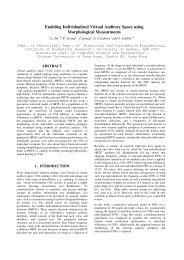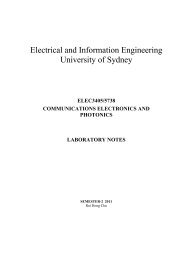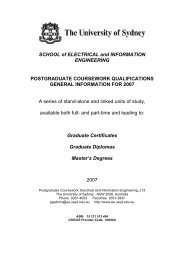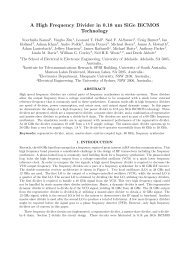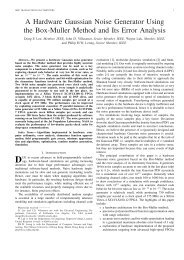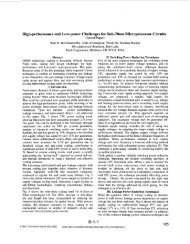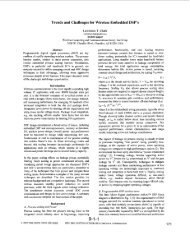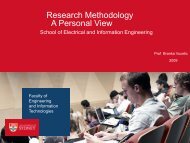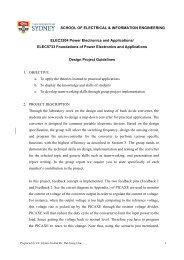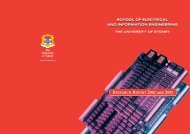An Analysis of the Coexistence of IEEE 802.11 DCF and IEEE ...
An Analysis of the Coexistence of IEEE 802.11 DCF and IEEE ...
An Analysis of the Coexistence of IEEE 802.11 DCF and IEEE ...
Create successful ePaper yourself
Turn your PDF publications into a flip-book with our unique Google optimized e-Paper software.
This full text paper was peer reviewed at <strong>the</strong> direction <strong>of</strong> <strong>IEEE</strong> Communications Society subject matter experts for publication in <strong>the</strong> WCNC 2007 proceedings.<strong>An</strong> <strong>An</strong>alysis <strong>of</strong> <strong>the</strong> <strong>Coexistence</strong> <strong>of</strong> <strong>IEEE</strong> <strong>802.11</strong><strong>DCF</strong> <strong>and</strong> <strong>IEEE</strong> <strong>802.11</strong>e EDCALixiang Xiong <strong>and</strong> Guoqiang MaoSchool <strong>of</strong> Electrical <strong>and</strong> Information EngineeringThe University <strong>of</strong> SydneyNSW 2006 AustraliaEmail: xlx@ee.usyd.edu.au, guoqiang@ee.usyd.edu.auAbstract— <strong>IEEE</strong> <strong>802.11</strong>e st<strong>and</strong>ard has been published in 2005.In <strong>the</strong> next few years, we may expect a proliferation <strong>of</strong> <strong>802.11</strong>ecapable stations. In <strong>the</strong> mean time, <strong>the</strong> legacy <strong>802.11</strong> stations willexist. Therefore, it is <strong>of</strong> practical significance to study <strong>the</strong> networkperformance when <strong>802.11</strong> stations <strong>and</strong> <strong>802.11</strong>e stations coexist.In this paper, a novel Markov chain based analytical modelis proposed to investigate <strong>the</strong> coexistence <strong>of</strong> <strong>DCF</strong> <strong>and</strong> EDCA,which are <strong>the</strong> fundamental access mechanisms for <strong>802.11</strong> <strong>and</strong><strong>802.11</strong>e respectively 1 . The performance impact <strong>of</strong> <strong>the</strong> differencesbetween <strong>DCF</strong> <strong>and</strong> EDCA is analyzed, including <strong>the</strong> contentionwindow (CW) size, <strong>the</strong> interframe space (IFS), <strong>the</strong> back<strong>of</strong>fcounter decrement rule, <strong>and</strong> <strong>the</strong> transmission timing when <strong>the</strong>back<strong>of</strong>f counter reaches zero. Based on <strong>the</strong> proposed model, <strong>the</strong>saturated throughput is analyzed. Simulation study is carried outto evaluate <strong>the</strong> accuracy <strong>of</strong> <strong>the</strong> proposed model.I. INTRODUCTION<strong>IEEE</strong> <strong>802.11</strong>e st<strong>and</strong>ard has been published in 2005. In <strong>the</strong>next few years, we may expect a proliferation <strong>of</strong> 801.22ecapable stations, which is referred to as QoS stations (QSTA)in <strong>the</strong> paper. In <strong>the</strong> mean time, <strong>the</strong> legacy <strong>802.11</strong> stations,referred to as non-QoS stations (non-QSTA) in <strong>the</strong> paper,will exist for a ra<strong>the</strong>r long time period. Therefore, it is <strong>of</strong>practical significance to study <strong>the</strong> network performance whennon-QSTAs <strong>and</strong> QTSAs coexist in <strong>the</strong> same base station setin which <strong>the</strong> access point (AP) is capable <strong>of</strong> supporting <strong>IEEE</strong><strong>802.11</strong>e st<strong>and</strong>ard.Distributed Coordination Function (<strong>DCF</strong>) <strong>and</strong> EnhancedDistribution Channel Access (EDCA) are <strong>the</strong> fundamentalaccess mechanisms for <strong>802.11</strong> <strong>and</strong> <strong>802.11</strong>e respectively. Themajor difference between <strong>DCF</strong> <strong>and</strong> EDCA is that <strong>DCF</strong> uses<strong>the</strong> same back<strong>of</strong>f parameter set for all stations, while EDCAclassifies traffic into four access categories (ACs), i.e., voice,video, best effort, <strong>and</strong> background, using a set <strong>of</strong> AC specificparameters, i.e., <strong>the</strong> contention window (CW) size, <strong>the</strong>interframe space (IFS) 2 , <strong>and</strong> <strong>the</strong> Transmission Opportunity(TXOP) limit. In addition, some o<strong>the</strong>r detailed differencesbetween <strong>DCF</strong> <strong>and</strong> EDCA exist [1]:1 This research is supported by <strong>the</strong> Australian Research Council’s Discoveryfunding scheme (project number DP0559248).2 A QSTA waits an AIFS (arbitration IFS) after a successful transmission<strong>and</strong> an EIFS (extended interframe space) after a collision. Here EIFS is <strong>the</strong>sum <strong>of</strong> an AIFS <strong>and</strong> an ACK timeout duration. For simplicity, we use <strong>the</strong>term “IFS E ” to represent both <strong>of</strong> <strong>the</strong>m when it is not necessary to specify<strong>the</strong>ir difference. Similarly, <strong>the</strong> term “IFS D ” is used to represent both DIFS(<strong>DCF</strong> IFS) <strong>and</strong> DIFS+ACK timeout time duration for non-QSTAs when <strong>the</strong>reis no need to specify <strong>the</strong>ir difference.1) Each time a station starts a new back<strong>of</strong>f procedure orresumes <strong>the</strong> suspended back<strong>of</strong>f procedure, it must sense<strong>the</strong> channel idle for a complete IFS interval from <strong>the</strong>end <strong>of</strong> <strong>the</strong> last busy channel. A QSTA will decreaseits back<strong>of</strong>f counter by one at <strong>the</strong> beginning <strong>of</strong> <strong>the</strong> timeslot immediately following <strong>the</strong> IFS E , irrespective <strong>of</strong><strong>the</strong> channel status in that time slot. In comparison,a non-QSTA must sense <strong>the</strong> channel idle in <strong>the</strong> timeslot immediately following <strong>the</strong> IFS D too in order todecrease its back<strong>of</strong>f counter by one at <strong>the</strong> beginning <strong>of</strong><strong>the</strong> next following time slot. That is, a non-QSTA needsto wait an extra idle time slot. A special case should benoted, when a non-QSTA or a QSTA starts a back<strong>of</strong>fprocedure with an initial back<strong>of</strong>f counter <strong>of</strong> zero, both<strong>of</strong> <strong>the</strong>m can start a transmission immediately after <strong>the</strong>corresponding IFS. This is <strong>the</strong> only case that a non-QSTA does not need to wait <strong>the</strong> extra time slot after <strong>the</strong>idle IFS D in its channel contention procedure.2) When a non-QSTA decreases its back<strong>of</strong>f counter tozero at <strong>the</strong> beginning <strong>of</strong> a time slot, it will start atransmission immediately, which is independent <strong>of</strong> <strong>the</strong>channel status in this time slot. On <strong>the</strong> contrary, a QSTAwill not transmit immediately when its back<strong>of</strong>f counteris decreased to zero at <strong>the</strong> beginning <strong>of</strong> a time slot. Itcan only start a transmission at <strong>the</strong> beginning <strong>of</strong> <strong>the</strong>next time slot provided that <strong>the</strong> channel remains idle in<strong>the</strong> current time slot. O<strong>the</strong>rwise <strong>the</strong> QSTA must wait acomplete idle IFS E after <strong>the</strong> busy channel <strong>and</strong> start <strong>the</strong>transmission after <strong>the</strong> IFS E .Extensive work has been done on analyzing <strong>the</strong> performance<strong>of</strong> <strong>DCF</strong> or EDCA separately. A comprehensive literaturereview can be found in [2], [3]. Comparatively, <strong>the</strong> coexistence<strong>of</strong> <strong>DCF</strong> <strong>and</strong> EDCA has not been given sufficient consideration.In [1], [4], some detailed differences between <strong>DCF</strong> <strong>and</strong> EDCAare discussed, but an analytical model was not given. In thispaper, we will propose a novel Markov chain based analyticalmodel for analyzing <strong>the</strong> coexistence <strong>of</strong> <strong>DCF</strong> <strong>and</strong> EDCA, where<strong>the</strong> aforementioned differences will be considered. The rest <strong>of</strong><strong>the</strong> paper is organized as <strong>the</strong> follows: Section II illustratesour proposed model; saturated throughput is analyzed inSection III; simulation study is shown in Section IV; finallySection V concludes <strong>the</strong> paper.1525-3511/07/$25.00 ©2007 <strong>IEEE</strong>2266
This full text paper was peer reviewed at <strong>the</strong> direction <strong>of</strong> <strong>IEEE</strong> Communications Society subject matter experts for publication in <strong>the</strong> WCNC 2007 proceedings.β _ 01−β _ 0− 1−β 1−β_ M −2_ M −11 β _10 1 M-1 Mβ _1 β _ M −1 1Fig. 5. The Markov chain model for modeling <strong>the</strong> number <strong>of</strong> consecutiveidle time slots between two successive transmissions in <strong>the</strong> system.<strong>and</strong> its expression is not given in in this paper due to lengthlimitation. With <strong>the</strong> solution <strong>of</strong> s(r), we may go fur<strong>the</strong>r toanalyze each system in detail.C. The system <strong>of</strong> non-QSTAs <strong>and</strong> QSTAs carrying voice orvideo traffic1) Average collision probabilities,ρ D <strong>and</strong> ρ E : 5 Accordingto Fig. 4(a), in zone 1, for a non-QSTA, only o<strong>the</strong>r non-QSTAswhich get involved in <strong>the</strong> previous transmission <strong>and</strong> QSTAsmay transmit <strong>and</strong> cause a collision. In zone 2, all o<strong>the</strong>r non-QSTAs <strong>and</strong> QSTAs may transmit <strong>and</strong> cause a collision. Thus<strong>the</strong> collision probability for a specific non-QSTA should bezone specific, which can be obtained by{ρD (1) = ∑ N D−1i=0{ [ ]1 − (1 − τ D ) i (1 − τ E ) NE ξ(i)},ρ D (2) = 1 − (1 − τ D ) ND−1 (1 − τ E ) NE ,( )ND − 1where ξ(i) =τiD i (1−τ D) ND−1−i represents <strong>the</strong>probability that i out <strong>of</strong> <strong>the</strong> remaining N D −1 non-QSTAs getinvolved in <strong>the</strong> previous transmission. For a QSTA, <strong>the</strong> zonespecific collision probability is given by{ρE (1) = ∑ N D{[i=0 1 − (1 − τD ) i (1 − τ E ) NE−1] φ(i) } ,ρ E (2) = 1 − (1 − τ D ) ND (1 − τ E ) NE−1 .Thus, <strong>the</strong> corresponding average collision probabilities can beobtained as <strong>the</strong> sum <strong>of</strong> <strong>the</strong> weighted contention zone specificcollision probabilities:{ρ D = ∑ M[ ]r=0 s(r) ρ D _ r ,ρ E = ∑ M[ ] (4)r=0 s(r) ρ E _ r .2) The average probabilities that <strong>the</strong> channel remains idlein a time slot, ω D <strong>and</strong> ω E : For a non-QSTA in <strong>the</strong> back<strong>of</strong>fcounter decrement procedure, it sees an “idle” time slot whenno o<strong>the</strong>r stations start a transmission in <strong>the</strong> same time slot.The zone specific probability that a non-QSTA sees an idletime slot is <strong>the</strong>n given by{ωD (1) = ∑ N D−1[i=0 (1 − τD ) i (1 − τ E ) NE ξ(i) ] ,ω D (2) = (1 − τ D ) ND−1 (1 − τ E ) NE .For a QSTA, we can obtain <strong>the</strong> zone specific probabilities as{ωE (1) = ∑ N D[i=0 (1 − τD ) i (1 − τ E ) NE−1 φ(i) ] ,ω E (2) = (1 − τ D ) ND (1 − τ E ) NE−1 .5 The average collision probabilities are not used in <strong>the</strong> proposed Markovchains directly, but <strong>the</strong>y will be used to obtain transition probabilities in <strong>the</strong>Markov chains.Thus, <strong>the</strong> corresponding average probabilities can also beobtained as <strong>the</strong> sum <strong>of</strong> <strong>the</strong> weighted contention zone specificcollision probabilities:{ω D = ∑ M[ ]r=0 s(r) ω D _ r ,ω E = ∑ M[ ]r=0 s(r) ω E _ r .3) The transition probabilities, γ D (d) <strong>and</strong> γ E (d): TheMarkov chains shown in Fig. 1 <strong>and</strong> 2 are used for this system,where γ D (d), d=1, 2 <strong>and</strong> γ E (1) are used.According to Fig. 4(a), <strong>the</strong> 1 st time slot <strong>and</strong> <strong>the</strong> 2 ndtime slot after <strong>the</strong> IFS D are located in zone 1 <strong>and</strong> zone 2respectively, <strong>and</strong> <strong>the</strong> 1 st time slot after <strong>the</strong> IFS E is locatedin zone 1, <strong>the</strong>refore we can have⎧⎨ γ D (1) = ∑ N D−1{[ ] }i=0 1 − (1 − τD ) i (1 − τ E ) NE ξ(i) ,γ D (2) = 1 − (1 − τ D ) ND−1 (1 − τ E ) NE ,⎩γ E (1) = ∑ N D{[i=0 1 − (1 − τD ) i (1 − τ E ) NE−1] φ(i) } .4) The probabilities that a station obtains an initial back<strong>of</strong>fcounter k, θ D (k) <strong>and</strong> θ E (k): Due to length limitation, justθ D (k) is analyzed in this paper. A new Markov chain is createdto model <strong>the</strong> number <strong>of</strong> transmission attempts <strong>of</strong> a non-QSTAfor sending a data frame, as shown in Fig. 6.1− ρ Dρ DρD1 1− ρ D 2ρD... ...1− ρ DρDh m-11− ρ DρDρDFig. 6. The Markov chain for modeling <strong>the</strong> number <strong>of</strong> transmission attempts<strong>of</strong> a non-QSTA for sending a data frame.In this Markov chain, h is <strong>the</strong> number <strong>of</strong> transmissionattempts for sending a data frame by which <strong>the</strong> range[0 CW max_D ] is firstly used, m is <strong>the</strong> maximum number <strong>of</strong>transmission attempts for sending a data frame, <strong>and</strong> ρ D is<strong>the</strong> average collision probability for a non-QSTA, which isobtained in (4). Each state (y) represents <strong>the</strong> y th transmissionattempt <strong>of</strong> a non-QSTA for sending a data frame. We can easilyobtain <strong>the</strong> steady state probability d(y), which represents <strong>the</strong>probability that <strong>the</strong> y th transmission attempt is implementedfor sending a data frame. Due to length limitation, <strong>the</strong> expression<strong>of</strong> d(y) is not given in this paper.Therefore, <strong>the</strong> probability θ D (k) that a non-QSTA stationobtains an initial back<strong>of</strong>f counter value k can be obtained byθ D (k) =m∑y=1d(y)c(k)CW(y)+1 ,where CW(y) is <strong>the</strong> CW value for <strong>the</strong> y th transmissionattempt for sending a data frame, which should follow <strong>the</strong>exponential increasing rule defined in <strong>IEEE</strong> <strong>802.11</strong> st<strong>and</strong>ard.c(k) is equal to ei<strong>the</strong>r 1 or 0. c(k) =1represents that <strong>the</strong>value k is included in <strong>the</strong> range [0 CW(y)], o<strong>the</strong>rwise it is notincluded.1m2269
This full text paper was peer reviewed at <strong>the</strong> direction <strong>of</strong> <strong>IEEE</strong> Communications Society subject matter experts for publication in <strong>the</strong> WCNC 2007 proceedings.The average time duration between two successive transmissioncan be obtained as:3.534 x 105 number <strong>of</strong> stations <strong>of</strong> each category<strong>DCF</strong>−simulation<strong>DCF</strong>−analysisEDCA voice−simulationEDCA voice−analysis3.534 x 105 number <strong>of</strong> stations <strong>of</strong> each category<strong>DCF</strong>−simulation<strong>DCF</strong>−analysisEDCA video−simulationEDCA video−analysisL =M∑{s (r) [(ψ D _ r + ψ E _ r )Tsr=0+ ɛ_ r Tc+ ϱ_ r TimeSlot]},where Ts <strong>and</strong> Tc are time required for a successful transmission<strong>and</strong> a collision respectively, which can also be consideredas known constants.Finally, <strong>the</strong> throughput for each station <strong>of</strong> each category canbe obtained by{T hroughput<strong>DCF</strong> = E[<strong>DCF</strong>]/L/N D ,T hroughput EDCA = E[EDCA]/L/N E .throughput (bits/sec)throughput (bits/sec)2.521.510.53.502 4 6 8 10 12 14 1632.521.510.5(a) <strong>DCF</strong> + EDCA voice<strong>DCF</strong>−simulation<strong>DCF</strong>−analysisEDCA best effort−simulationEDCA best effort−analysisthroughput (bits/sec)throughput (bits/sec)2.521.510.53.502 4 6 8 10 12 14 1632.521.510.5(b) <strong>DCF</strong> + EDCA video<strong>DCF</strong>−simulation<strong>DCF</strong>−analysisEDCA background−simulationEDCA background−analysis4 x 105 number <strong>of</strong> stations <strong>of</strong> each category4 x 105 number <strong>of</strong> stations <strong>of</strong> each categoryIV. SIMULATION STUDYThe simulation study is carried out with OPNET [6]. Theparameter setting <strong>of</strong> <strong>DCF</strong> <strong>and</strong> EDCA is as shown in Table-I,which is consistent with those defined in [7, Table 20df, p.49].02 4 6 8 10 12 14 16(c) <strong>DCF</strong> + EDCA best effortFig. 7.02 4 6 8 10 12 14 16(d) <strong>DCF</strong> + EDCA backgroundSimulation <strong>and</strong> analytical results.TABLE IWLAN SIMULATION PARAMETER SETTINGFrame payload size8000 bitsdata rate1MbpsMaximum retransmission limit 7<strong>DCF</strong> parameter set CW min =31, CW max = 1023,DIFS=SIFS+2TimeSlotEDCA voice parameter set CW min =7,CW max =15,AIFS=DIFSEDCA video parameter set CW min =15,CW max =31,AIFS=DIFSEDCA best effort parameter set CW min =31,CW max = 1023,AIFS=DIFS+TimeSlotEDCA background parameter set CW min =31,CW max = 1023,AIFS=DIFS+5TimeSlotFour scenarios are simulated, <strong>and</strong> each <strong>of</strong> <strong>the</strong>m containsequal number <strong>of</strong> non-QSTAs <strong>and</strong> QSTAs <strong>of</strong> one traffic class.The results are shown in Fig. 7.As shown in Fig. 7, <strong>the</strong> analytical results from <strong>the</strong> proposedmodel can generally agree well <strong>the</strong> simulation results,especially when <strong>the</strong> number <strong>of</strong> stations is large. However, alarger discrepancy between <strong>the</strong> analytical <strong>and</strong> <strong>the</strong> simulationresults at smaller number <strong>of</strong> stations is observed. It results from<strong>the</strong> assumption used in <strong>the</strong> model, that is, <strong>the</strong> transmissionprobability at a generic time slot is constant. This assumptionis more accurate when <strong>the</strong> number <strong>of</strong> stations is larger [8].We observe <strong>the</strong> significant priority <strong>of</strong> EDCA voice or videoover <strong>DCF</strong>, as well as that <strong>of</strong> <strong>DCF</strong> over EDCA background,which are caused by <strong>the</strong> large difference between <strong>the</strong>ir CWsizes or IFSs. A slight priority <strong>of</strong> <strong>DCF</strong> over EDCA besteffort is also observed, which results from that IFS D isone time slot shorter than IFS E . It is obvious that trafficpriority differentiation can still be implemented effectively in<strong>the</strong> coexistence condition. However, <strong>the</strong> results also imply thatnon-QSTAs may suffer a serious service starvation if <strong>the</strong>ycoexist with QSTAs carrying voice or video traffic.V. CONCLUSION AND FUTURE WORKIn this paper, we proposed a novel Markov chain basedanalytical model for investigating <strong>the</strong> coexistence performance<strong>of</strong> <strong>DCF</strong> <strong>and</strong> EDCA. Some important factors were consideredin our analysis, including <strong>the</strong> CW size, <strong>the</strong> IFS, <strong>the</strong> back<strong>of</strong>fcounter decrement rule, <strong>and</strong> <strong>the</strong> transmission timing when <strong>the</strong>back<strong>of</strong>f counter reaches zero. We also obtained <strong>the</strong> saturatedthroughput with <strong>the</strong> proposed model. The simulation studyverified <strong>the</strong> accuracy <strong>of</strong> <strong>the</strong> proposed model. The results weobserved indicated that traffic priority differentiation can stillbe effectively implemented in <strong>the</strong> coexistence environment,but non-QSTAs may suffer a serious service starvation bycoexisting with QSTAs carrying high-priority traffic. However,only <strong>the</strong> simple scenarios are analyzed in this paper, <strong>and</strong> weconsider that more complex <strong>and</strong> more practical coexistencescenarios should be analyzed in our future research for fur<strong>the</strong>rinvestigation.REFERENCES[1] G. Bianchi, I. Tinnirello, <strong>and</strong> L. Scalia, “Underst<strong>and</strong>ing <strong>802.11</strong>econtention-based prioritization mechanisms <strong>and</strong> <strong>the</strong>ir coexistence withlegacy <strong>802.11</strong> stations,” Network, <strong>IEEE</strong>, vol. 19, no. 4, pp. 28–34, 2005.[2] L. Xiong <strong>and</strong> G. Mao, “Saturated throughput analysis <strong>of</strong> <strong>IEEE</strong> <strong>802.11</strong>eusing two-dimensional Markov chain model,” in The Third InternationalConference on Quality <strong>of</strong> Service in Heterogeneous Wired/Wireless Networks(QShine), Waterloo, Canada, July, 2006.[3] E. A. Venkatesh Ramaiyan, <strong>An</strong>urag Kumar, “Fixed point analysis <strong>of</strong> singlecell <strong>IEEE</strong> <strong>802.11</strong>e WLANs: uniqueness, multistability <strong>and</strong> throughputdifferentiation,” SIGMETRICS Perform. Eval. Rev., vol. 33, no. 1, pp.109–120, 2005.[4] J. Majkowski <strong>and</strong> F. Casadevall Palacio, “<strong>Coexistence</strong> <strong>of</strong> <strong>IEEE</strong> <strong>802.11</strong>B<strong>and</strong> <strong>IEEE</strong> <strong>802.11</strong>E Stations in QoS Enabled Wireless Local Area Network,”in Communication Systems <strong>and</strong> Applications 2006, 2006.[5] J. Robinson <strong>and</strong> T. R<strong>and</strong>hawa, “Saturation throughput analysis <strong>of</strong> <strong>IEEE</strong><strong>802.11</strong>e enhanced distributed coordination function,” Selected Areas inCommunications, <strong>IEEE</strong> Journal on, vol. 22, no. 5, pp. 917–928, 2004.[6] OPNET University Program, http://www.opnet.com/services/university/.[7] <strong>IEEE</strong> <strong>802.11</strong>e st<strong>and</strong>ard, 2005.[8] G. Bianchi, “Performance analysis <strong>of</strong> <strong>the</strong> <strong>IEEE</strong> <strong>802.11</strong> distributed coordinationfunction,” Selected Areas in Communications, <strong>IEEE</strong> Journal on,vol. 18, no. 3, pp. 535–547, 2000.2271



